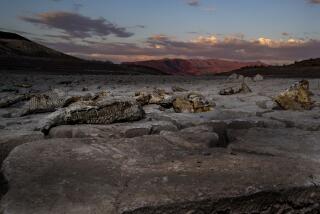Tapped out
One of the downsides to global warming is drought. About 11 million people in northeast Africa alone were in serious danger of starvation in 2006 as a result of drought. The International Institute of Tropical Agriculture in Nigeria estimates that about 300 million people in sub-Saharan Africa -- nearly a third of the population -- will suffer from malnutrition because of intensifying drought by 2010. With continued warming and more droughts on the horizon, we need to learn how to better live with our natural world and its cycles.
Here in the Western United States, it’s tree rings that tell us that cycles of wet and dry, warm and cool are the historical reality.
In California, the source is tree stumps in Sierra lake beds. Owens Lake once covered more than 115 square miles at the mouth of the Owens River. The mountain runoff that fed the lake varied dramatically in cycles of wet and dry years. In drier periods, trees grew in the still-moist soil of the receding lake. When the rains came, the trees drowned, leaving stumps as a chronicle of aridity: An epochal drought began before AD 910 and ended about 1100; a wetter century then ensued, when rainfall was higher than in modern times. A second drought started before 1210 and ended 140 years later.
As for the wider West, a grid of more than 600 tree-ring sequences from throughout the region, compiled by a team at the Lamont-Doherty Tree Ring Laboratory at Columbia University, puts today’s droughts in perspective. The centuries between AD 900 and 1253 witnessed long dry spells. After 1300, an abrupt change to wetter conditions lasted for 600 years, then gave way to today’s aridity. Some people refer to a “mega-drought epoch” 1,000 years ago, when cool, dry La Nina conditions persisted for decades over the eastern Pacific and the winter jet stream stayed well north of what is now California.
None of today’s droughts approach the intensity and duration of the medieval ones. The six-year California drought that began in 1987 resulted in Sierra Nevada runoff that was only 65% of normal. During the great medieval droughts, inflow to Owens Lake is estimated to have been 45% to 50% lower than usual.
Why did the medieval droughts persist so long? Gradually accumulating climatic evidence from around the world is showing that the mega-drought epoch experienced significant warming on a global level, similar to recent conditions. During the 20th century, increased Northern Hemisphere temperatures and unusual warming of the western Pacific and Indian oceans contributed to drought formation over middle latitudes.
How did people survive? A thousand years ago, California’s human population was tiny, a scattering of hunters, gatherers and fishermen who adapted effortlessly to long-term drought. They tapped rare permanent water supplies, changed their diet and moved to higher ground. Acorns were a staple; so were sea fish in places such as the Santa Barbara Channel. Survival in some of the toughest landscapes on Earth depended on cooperation, intelligence about water supplies, mobility and flexibility, knowledge of their environment and on taking advantage of all kinds of food resources when they became available. Nevertheless, prolonged aridity must have killed thousands of people in medieval times, from the American West to the Saharan Sahel.
Although today’s droughts are minuscule compared with the dry spells of 1,000 years ago, the future is truly frightening. Sophisticated computer models by Britain’s Hadley Center for Climate Prediction and Research predict a 3% to 18% increase in the amount of the Earth’s surface that will be exposed to extreme drought by 2100; 40% of the world will suffer from severe drought, up from the current 18%; 50% will suffer from moderate drought. California and other Western states, at the very least, will suffer from severe drought. By 2025, an estimated 2.8 billion of us will live in arid areas like California.
Today, we harvest water on an industrial scale -- from rainfall, from rivers and lakes and from rapidly shrinking water tables. Many of us in California live off what are, effectively, looted water supplies, brought by canal from Owens Lake or the Colorado River or drained from aquifers.
But at best we have accommodated ourselves to nature’s fickle realities. Our greatest asset is not necessarily our technology but our opportunism and endless capacity to adapt to circumstances. We must learn from the history of the great droughts and begin to think of ourselves as partners with, rather than potential masters of, the changing natural world.
More to Read
Sign up for Essential California
The most important California stories and recommendations in your inbox every morning.
You may occasionally receive promotional content from the Los Angeles Times.










